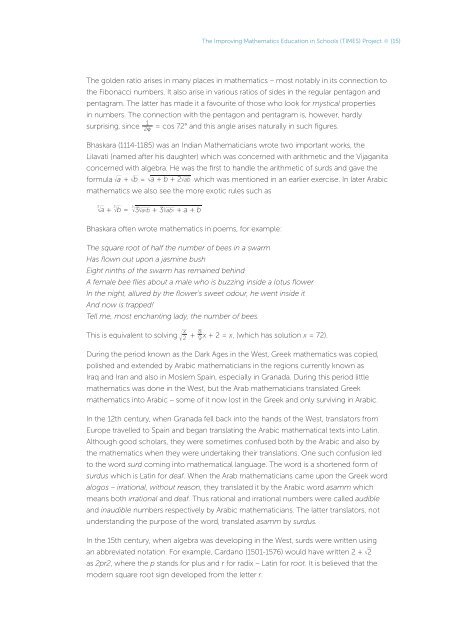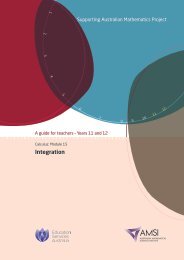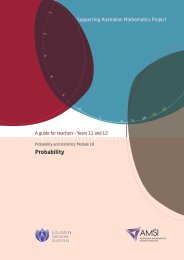PDF Version of module - the Australian Mathematical Sciences ...
PDF Version of module - the Australian Mathematical Sciences ...
PDF Version of module - the Australian Mathematical Sciences ...
You also want an ePaper? Increase the reach of your titles
YUMPU automatically turns print PDFs into web optimized ePapers that Google loves.
The Improving Ma<strong>the</strong>matics Education in Schools (TIMES) Project{15}The golden ratio arises in many places in ma<strong>the</strong>matics – most notably in its connection to<strong>the</strong> Fibonacci numbers. It also arise in various ratios <strong>of</strong> sides in <strong>the</strong> regular pentagon andpentagram. The latter has made it a favourite <strong>of</strong> those who look for mystical propertiesin numbers. The connection with <strong>the</strong> pentagon and pentagram is, however, hardly1surprising, since 2 = cos 72° and this angle arises naturally in such figures.Bhaskara (1114-1185) was an Indian Ma<strong>the</strong>maticians wrote two important works, <strong>the</strong>Lilavati (named after his daughter) which was concerned with arithmetic and <strong>the</strong> Vijaganitaconcerned with algebra. He was <strong>the</strong> first to handle <strong>the</strong> arithmetic <strong>of</strong> surds and gave <strong>the</strong>formula a + b = a + b + 2 ab which was mentioned in an earlier exercise. In later Arabicma<strong>the</strong>matics we also see <strong>the</strong> more exotic rules such as3a+ 3 3 3b = 3 a 2 b3+ 3 ab 2+ a + bBhaskara <strong>of</strong>ten wrote ma<strong>the</strong>matics in poems, for example:The square root <strong>of</strong> half <strong>the</strong> number <strong>of</strong> bees in a swarmHas flown out upon a jasmine bushEight ninths <strong>of</strong> <strong>the</strong> swarm has remained behindA female bee flies about a male who is buzzing inside a lotus flowerIn <strong>the</strong> night, allured by <strong>the</strong> flower’s sweet odour, he went inside itAnd now is trapped!Tell me, most enchanting lady, <strong>the</strong> number <strong>of</strong> bees.This is equivalent to solving x2 + 8 9 x + 2 = x, (which has solution x = 72).During <strong>the</strong> period known as <strong>the</strong> Dark Ages in <strong>the</strong> West, Greek ma<strong>the</strong>matics was copied,polished and extended by Arabic ma<strong>the</strong>maticians in <strong>the</strong> regions currently known asIraq and Iran and also in Moslem Spain, especially in Granada. During this period littlema<strong>the</strong>matics was done in <strong>the</strong> West, but <strong>the</strong> Arab ma<strong>the</strong>maticians translated Greekma<strong>the</strong>matics into Arabic – some <strong>of</strong> it now lost in <strong>the</strong> Greek and only surviving in Arabic.In <strong>the</strong> 12th century, when Granada fell back into <strong>the</strong> hands <strong>of</strong> <strong>the</strong> West, translators fromEurope travelled to Spain and began translating <strong>the</strong> Arabic ma<strong>the</strong>matical texts into Latin.Although good scholars, <strong>the</strong>y were sometimes confused both by <strong>the</strong> Arabic and also by<strong>the</strong> ma<strong>the</strong>matics when <strong>the</strong>y were undertaking <strong>the</strong>ir translations. One such confusion ledto <strong>the</strong> word surd coming into ma<strong>the</strong>matical language. The word is a shortened form <strong>of</strong>surdus which is Latin for deaf. When <strong>the</strong> Arab ma<strong>the</strong>maticians came upon <strong>the</strong> Greek wordalogos – irrational, without reason, <strong>the</strong>y translated it by <strong>the</strong> Arabic word asamm whichmeans both irrational and deaf. Thus rational and irrational numbers were called audibleand inaudible numbers respectively by Arabic ma<strong>the</strong>maticians. The latter translators, notunderstanding <strong>the</strong> purpose <strong>of</strong> <strong>the</strong> word, translated asamm by surdus.In <strong>the</strong> 15th century, when algebra was developing in <strong>the</strong> West, surds were written usingan abbreviated notation. For example, Cardano (1501-1576) would have written 2 + 2as 2pr2, where <strong>the</strong> p stands for plus and r for radix – Latin for root. It is believed that <strong>the</strong>modern square root sign developed from <strong>the</strong> letter r.
















